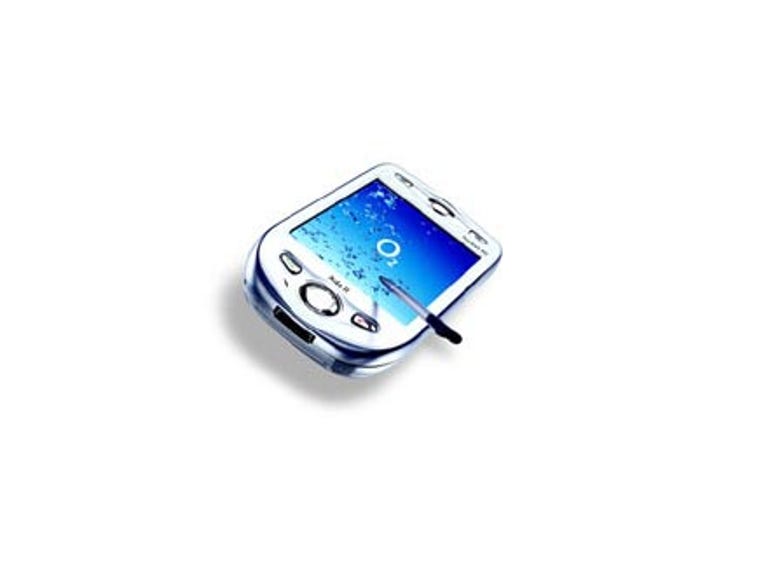 Why You Can Trust CNET
Why You Can Trust CNET O2 Xda II review: O2 Xda II
O2's Xda II combines a tri-band GPRS/GSM phone with Bluetooth, a digital camera, 128MB of RAM and a SDIO slot into a sleek Pocket PC-based device. Read our Australian review.
O2 has targeted the enterprise users since entering the Australian mobile marketplace with the Xda. It seems O2 is now strategically approaching the converging devices market with their latest releases, the Xphone and the Xda II. The Xphone, targets users on one side of the fence who like their mobile phones with added PDA-like functionality, and on the other is the Xda II, a powerful PDA with phone functionality tacked on.
The Good
The Bad
The Bottom Line
The Xda II still boasts its predecessor's sleek, silver design but bestows a much smoother guise due to the external stump antenna being chopped off. Antenna aside, the casing is very similar in size to the original, measuring 70 x 130 x 19 mm. There's no denying the Xda II looks like a PDA. Its specs even outshine some of the best pure PDAs (without phone functionality) available on the market.
Running Microsoft's verbosely-titled Windows Mobile 2003 Software for Pocket PC Phone Edition, the Xda II will be competing with other smartphones such as the Treo 600 (which uses Palm OS), and the Sony Ericsson P900 (Symbian OS-based).
Key features have been considerably bumped up on this latest incarnation of the Xda. Its massive 65,000-colour LCD takes up 74 x 56 mm of the front of the device and appears clear and bright in a range of lighting conditions, thanks to a transflective screen. Housed under its silver exterior is a 400MHz Intel XScale PXA 263 processor with 128MB of RAM, double the amount of memory found in the original Xda.
Layout of the keys is pretty much the same as its predecessor; calendar and contact shortcut keys at the top of the screen, answer and end keys surrounding a clickable navigation pad at the bottom. The SD/IO slot has jumped to the at the top of the phone wedged between the power button and infrared port.
A digital camera with a maximum resolution of 640 x 480 pixels is located on the back of the Xda and a camera shortcut key is conveniently placed on the left side of the unit along with a volume switch and notes shortcut key -- ergonomically designed for easy reach with a swift press of your thumb. Clicking the camera key once turns the entire display into the viewfinder. Clicking again captures photos. Video with sound can be captured at 15 fps and played back on the device through Windows Media Player. MP3's and video stored in memory or on SD cards can also be played back. O2 supplies a stereo headset with the Xda II but the Bluetooth headset is a separate purchase.
O2 provides a docking station that connects the Xda II with your PC via a USB connection. With Microsoft ActiveSync software (a free download from Microsoft's site) you can synchronise data such as contacts, e-mails, files, calendar appointments and notes. Dropping WAV files into various Windows directories on the Xda II allows them to be assigned as ringtones or other alerts.
Text input methods can be changed easily between Block Recognizer (for users familiar with Palm's Graffiti), Letter Recognizer (for users of Jot from CIC), a virtual keyboard (which is just big enough in large mode to thumb-type with), and our favourite, the transcriber. Impressing not only us but all who gave it a try, the transcriber translates whole words written with the stylus onto the screen. The handwriting recognition software is quite accurate and can be taught to look for (or omit) certain writing-style variations of letters, cursive or printed.
From the Xda II's desktop you can see the start menu at the top left with network and sound icons plus the time to the right. Under this system bar is the Today screen which features customisable wallpaper, today's date, owner information, Bluetooth settings, and the status of appointments, messages and tasks.
A speech bubble pops up when an incoming call is received and the caller ID shows the contact's name, photo number and picture (if one has previously been set through the Photo Contacts application). Similarly, when an SMS/MMS arrives a speech bubble instantly appears with the sender's name and the message shown beneath.
Located in the programs folder are applications to view PDF documents and PowerPoint presentations. Pocket Office applications (Word and Excel) can also be found here for basic document manipulation and Pocket Internet Explorer is installed for browsing the Web. Two basic games are installed; Jawbreaker and Solitaire.
Tri-band network capability will garner a warm welcome from travellers. On the other hand, battery life will present a problem for some users. Generally, we had to charge the device at least every two days. The battery is replaceable, so road warriors might be inclined to purchase a spare, but be warned: data stored in RAM may be lost if the battery is removed for more than twenty minutes, according to the user manual.
Business users and tech aficionados will see the allure of this device. It is an excellent PDA with phone functionality at a reasonable price point. Mainstream mobile users will find the Xda II overkill for their needs, both with its plethora of features and its large size.


